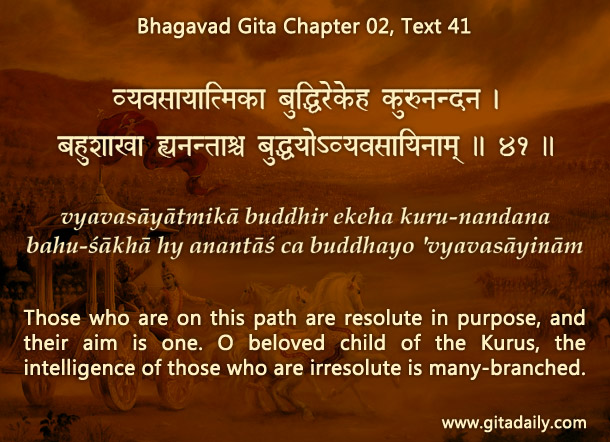Intention refers to conscious determination to do a particular thing. Intensity refers to wholehearted absorption in doing that thing.
Our spiritual practices frequently lack intensity. For example, when we meditate, often our mind doesn’t focus on the object of meditation, Krishna, but instead wanders to various worldly objects. Unintense devotional practices provide little taste because taste comes primarily when our consciousness connects with Krishna who manifests when we practice devotional service wholeheartedly.
Suppose a mother offers a delicious juice to her baby by pouring it into his mouth. But if the baby gets infatuated with something else and turns his face away from the juice, he can’t enjoy its taste. Our mind is like that unintelligent baby – it gets infatuated with worldly things and turns our attention away from Krishna even while we engage externally in devotional activities. As we are thus distracted, our devotional practices seem tasteless.
Rather than just berating ourselves for being halfhearted or pushing ourselves by brute force to concentrate, we can take a mental step backwards and ask ourselves: “Why am I doing this?”
How do we increase our intensity?
By probing and purifying our intention.
Rather than just berating ourselves for being halfhearted or pushing ourselves by brute force to concentrate, we can take a mental step backwards and ask ourselves: “Why am I doing this? Why is it important? What convinces me personally that it is important for me?” Such introspection pushes our consciousness towards the words of scripture, which gives the intellectual rationale for devotional service. Further, because scripture is a manifestation of the all-pure Supreme, contemplation on it purifies us, thereby reinforcing our pure spiritual intention. Pertinently, the Bhagavad-gita (02.41) indicates that focused intelligence is the foundation of spiritual success.
When we are thus convinced that devotional service is important for us, we naturally feel inspired to concentrate on it and to drag our mind back to it even if it wanders. By such intentional and intense practice, our devotional service soon becomes tasteful and fruitful.

Explanation of article:

Disappointed that you still don’t say Based on Bhagavad gita As it is by Srila Prabhupada
So pl discontinue my subscription as I do not want to subscribe unauthorized commentaries on BG
Please quote at least one instruction of Srila Prabhupada stating that every article on the Bhagavad-gita written by his followers has to state that it is based on his Bhagavad Gita As It Is.
Even ISKCON’s official magazine Back to Godhead doesn’t state that in each article – it states it once prominently in the introductory pages – and I have done the same on the homepage of this site.
Does an article become authorized merely by stating that it is based on Srila Prabhupada’s Gita? Its content is what matters, not its self-declaration.
And the content of these Gita articles has been appreciated by prominent scholarly followers of Srila Prabhupada. Here are a couple of quotes from the Gita for Daily Enrichment book which is a compilation of these articles from 2012:
*
“Wisdom texts like the Bhagavad-gita become especially useful when they are brought into modernity by mature and articulate scholar-practitioners. Chaitanya Charan Das is one such person. Through his “Gita for Daily Enrichment,” he un- locks many of the mysteries of the text, allowing contemporary readers access to an otherwise often impenetrable scripture.”
– Steven J. Rosen (Satyaraja Dasa),
Editor, Journal of Vaishnava Studies and Back to Godhead Magazine, and author of some 30 books on spiritual topics.
***
The Bhagavad-gita for Daily Enrichment provides readers with succinct, thought- ful meditations based on verses from the Gita. It connects the transcendent scripture to daily life’s questions, struggles, and triumphs.
It shows us how Krishna addresses our deepest concerns with profound yet sub- lime answers. It is written for those who are trying to live by the Gita’s tenets in the practice of bhakti yoga–both the beginner in bhakti and the serious practi- tioner of it. It is eminently useful both for the meditative monk and those wanting to connect with Krishna while living and working in the world. Each daily medita- tion can be read in a few moments, or savored longer while referencing the verse and purport of that day’s focus. Either way, the spiritual connection offered by these meditations will help to remind the reader throughout the day of the Gita’s wisdom and insight, and bring us to a higher dimension of life.
– Dr Edith Best (Urmila Devi Dasi),
Author of several acclaimed books for children, Member of ISKCON’s Shastric Advisory Council and Editor of Back to Godhead
***
Chaitanya Charan is a genuine Bhagavad gita scholar, in that he approaches this Indian classic in a reverential and meditational mood. His book offers that which may be called “Humanistic Hinduism”, i.e. a view which shows the relevance and
vibrancy of Hinduism as a living tradition. It addresses a wide variety of topics such as divinity, desire, human psychology, religion and dharma. I very warmly rec- ommend not only reading but immersing oneself in this book.
– Dr. Ithamar Theodor (Isvara Krishna Das)
Author of “Exploring the Bhagavad gita; Philosophy, Structure and Meaning” Director, The Program for Hindu-Jewish Studies Dept. of Asian Studies, University of Haifa
You are free to read or not read these articles – my best wishes are there with you either way. But I would be more cautious in labeling any articles as unuathorized based on a simplistic notion of self-declartion of authenticity – a notion whose authenticity is itself very much open to question.
ys
ccdas